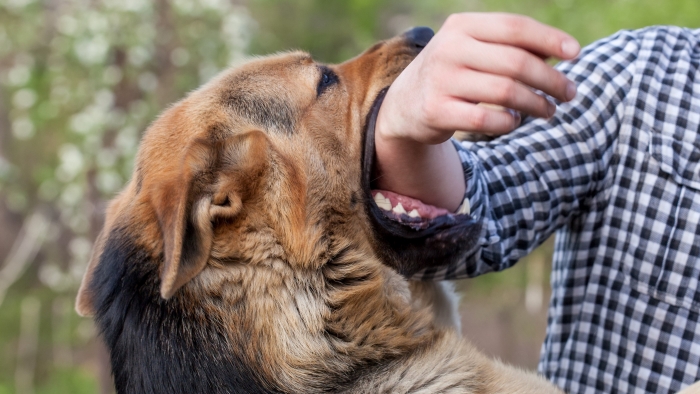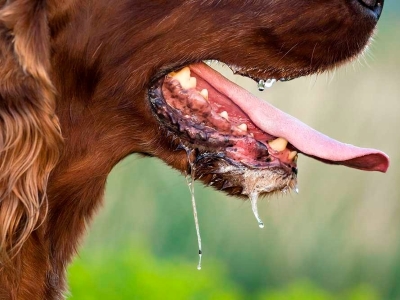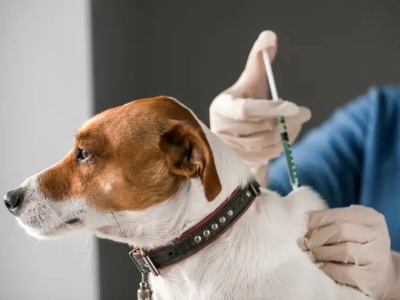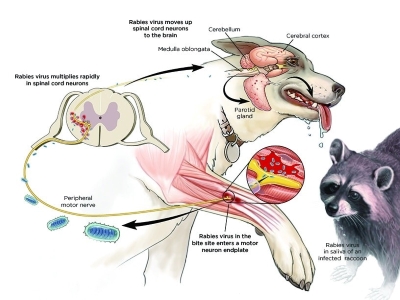Rabies is a deadly viral disease that affects mammals, including dogs and humans.
While advancements in veterinary medicine have made rabies relatively rare in developed countries, it still poses a significant threat, especially in regions with limited access to vaccination programs.

In this blog, we will delve into the details of rabies in dogs, including its causes, symptoms, prevention, and treatment.
Contents
What is Rabies?
The rabies virus, which is a member of the Lyssavirus genus, is what causes the viral illness known as rabies.
Usually, the virus is spread by an infected animal’s saliva, most frequently through bites.

Once within the body, the virus passes through the nerve system before arriving at the brain, where it causes severe inflammation[1].
Once clinical signs start to manifest, the disease advances quickly and frequently results in death.
Symptoms of Rabies in Dogs
Dogs are animals, including those that are affected by the viral illness rabies, which damages the brain system.
Typically, an infected animal’s saliva spreads the illness when it bites another animal[2].

Being aware of the symptoms in dogs is crucial since rabies is a dangerous and sometimes deadly infection.
Not all sick dogs will exhibit the same symptoms, so keep that in mind.
Typical signs of canine rabies include the following:
Behavioral Changes
Rabies can cause significant behavioral changes in dogs. They might become unusually aggressive or irritable.
Conversely, some dogs may become more docile or withdrawn than usual.
Excessive Salivation (Drooling)
One of the hallmark signs of rabies is excessive salivation.
Dogs with rabies often exhibit an inability to swallow due to paralysis of the throat muscles, leading to drooling[3].
Difficulty Swallowing
Dogs with rabies might have difficulty swallowing, which can contribute to the excessive drooling mentioned above.
Changes in Vocalization
A normally quiet dog might become unusually vocal, while a typically noisy dog might become quiet.
Muscle Weakness and Paralysis
Canines may endure muscular wasting and possibly paralysis as the illness worsens.
Their capacity to stand, walk, or coordinate their motions may be hampered by this.
Aggression
Some canines that have rabies may develop unusually high levels of anger toward people, other animals, or things.
They could bite without being provoked; therefore, this is a potentially hazardous condition.
Fever and Lethargy
Infected dogs might run a fever and appear lethargic or weak.
Disorientation and Incoordination
Rabies affects the central nervous system, leading to disorientation, incoordination, and difficulty maintaining balance.
Dogs might stumble, have trouble walking straight, or appear disoriented.
Hypersensitivity to Stimuli
Dogs with rabies can develop hypersensitivity to touch, sound, and light.
In response to these signals, they could overreact.
Change in Appetite
Changes in appetite may result from rabies.
While some dogs may exhibit a decrease in appetite, others may exhibit an increase.
How to Prevent Rabies in Dogs
Vaccinating dogs on a regular basis is the best way to protect them from rabies.
The American Kennel Club recommends that pups receive their first rabies vaccination between the ages of 12 and 16 weeks, followed by a booster shot a year later.
After that, depending on the type of vaccination and local regulations, kids should have a booster shot every one to three years[4].

The rabies vaccine not only shields your dog from the disease but also aids in halting its transmission to both humans and other animals.
Avoiding contact with wild creatures like skunks, foxes, raccoons, and bats that may be carriers of the virus is another strategy to protect dogs from contracting rabies.
Keep your dog on a leash when outdoors, and don’t allow them to pursue animals or roam free.
Stay away from odd or violent wild animals and report them to your neighborhood’s law enforcement.
Even if a wild animal appears friendly or injured, never attempt to feed, handle, or catch it.
How to Treat Rabies in Dogs
Unfortunately, there is no cure for rabies in dogs once symptoms develop.
The only way to confirm a diagnosis of rabies is by testing brain tissue after death.
Therefore, if your dog shows any signs of rabies, you should contact your veterinarian immediately and isolate your dog from other animals and people.

Do not attempt to handle or restrain your dog without proper protection, as they may bite or scratch you.
You should also call your veterinarian right away if your dog has been bitten by an animal that may be rabid.
Your dog will be examined to see whether they require additional medical attention or a booster vaccination.
They can also provide you with advice on how to report the occurrence to the local authorities and how to keep an eye out for any rabies symptoms in your dog.
Dr. Jamie Richardson, medical chief of staff at Small Door Veterinary, suggests on The American Kennel Club that “You should never come in contact with your dog’s saliva if you suspect rabies transmission has occurred. Once you get your dog out of the house, it’s critical to disinfect any areas where your dog may have been infected, particularly with saliva. You can use a 1:32 dilution (4 ounces to a gallon) of household bleach solution to inactivate the virus quickly.”
If you have been bitten or scratched by a potentially rabid animal or by a dog showing signs of rabies, you should seek medical attention right away.
You may need to receive a series of shots called post-exposure prophylaxis (PEP) to prevent infection.
PEP is most effective if given within 24 hours of exposure.
FAQs
Can rabies in dogs be treated?
Unfortunately, there is no cure for rabies once symptoms manifest. Euthanasia is often the only humane option to prevent further suffering and protect human health.
When should I vaccinate my dog against rabies?
Puppies should receive their first rabies vaccine between 12-16 weeks of age. Regular booster shots are necessary to maintain immunity.
Can rabies be transmitted to humans from dogs?
Yes, rabies can be transmitted from infected dogs to humans through bites or scratches. It’s crucial to take rabies exposure seriously and seek immediate medical attention if bitten by an animal with an unknown vaccination status.
Can I administer the rabies vaccine at home?
It’s best to have the rabies vaccine administered by a licensed veterinarian. They can ensure proper handling, administration, and documentation, which is essential for legal and health reasons.
Is rabies a global concern?
Yes, rabies is a global issue. It affects many countries, particularly those with limited resources for controlling and preventing its spread. Eradicating rabies requires coordinated efforts, including vaccination campaigns and responsible pet ownership.
Conclusion
Both people and dogs can contract the deadly and lethal illness rabies.
Regular canine vaccinations and avoiding contact with wild animals that could be infected with the virus will help prevent it.
Consult your veterinarian right away if your dog has been exposed to rabies or exhibits any symptoms of it, and then heed their advice.
You can save your dog and yourself from this terrible illness by being informed and responsible.
I hope this blog helps you understand more about rabies in dogs.
Thank you for reading! 😊
Reference:
- The nervous system of dogs | MSD Veterinary Manual
- Canine parvovirus | Cornell University College of Veterinary Medicine
- Why your dog is excessively drooling | PetMD
- Your complete guide to First-Year puppy vaccinations | American Kennel Club

Dania is a dog groomer living in California, who loves styling dogs. She often uses dog accessories to keep them distracted while grooming. She is also a dog parent to a Pomeranian, Duke. It’s because of him she is always on a lookout for the best dog foods, toys, other dog accessories, and ways to keep him equipped, healthy and happy.


